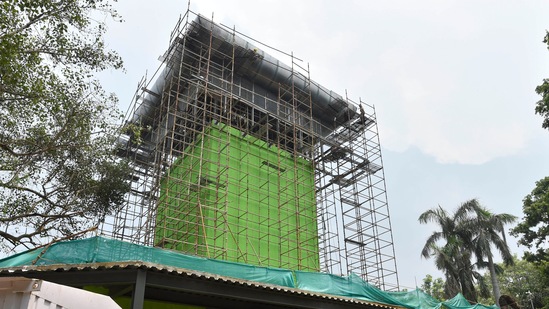Delhi smog tower cleans air, but test continue on efficacy and range
Now, the Delhi Pollution Control Committee(DPCC ) plans to test its effective range to determine whether the tower is actually improving air quality in the surrounding area.
Preliminary data submitted by the Indian Institute of Technology Bombay to the Delhi Pollution Control Committee (DPCC) shows a 50-60% reduction in PM 2.5 concentration, but only between the inlet and the outlet of the smog tower installed at Connaught Place earlier this year.

Now, the Delhi Pollution Control Committee(DPCC ) plans to test its effective range to determine whether the tower is actually improving air quality in the surrounding area. To do this, the committee has installed sensors every 100 metres from the smog tower. DPCC officials say the data collected will be able to give a better idea on the smog tower’s effectiveness.
Experts have long argued that smog towers are not a long-term solution to Delhi’s air pollution problem, and that not only would people have to remain extremely close to the smog tower to breathe clean air, but thousands of such smog towers would have to be installed all across the city to bring about a change in air quality.
“Like any purifier or smog tower in this case, there will be some reduction in the air quality readings at the outlet, but we are now looking to identify the exact impact and how big the radius of the relatively cleaner air is,” said a DPCC official involved in the project who asked not to be named.
“After three months since testing first began, a detailed quarterly report will be generated,” the official added.
After the smog tower became operational in October, DPCC has been receiving daily air pollution reports from IIT Bombay. The tower is located next to the Shivaji Stadium metro station. Real-time readings are being displayed on a giant screen installed outside the smog tower.
One such a daily report, reviewed by HT for November 21, showed the inlet PM 2.5 concentration at 9 am to be 383 micrograms per cubic metre. The concentration at the outlet was found to be 223 micrograms per cubic metre.
When HT visited the smog tower the following day, when Delhi’s air quality index (AQI) was 311 (very poor), the giant screen outside the tower displayed the outside PM 2.5 concentration to be 140 micrograms per cubic metre, with the treated air having a concentration of 73 micrograms per cubic metre.
Similarly, on HT’s visit on December 2, when AQI was 429 (severe), the smog tower displayed a PM 2.5 concentration of 460 micrograms per cubic metre outside the tower, while the controlled air was said to have a PM 2.5 concentration of 324 micrograms per cubic metre.
To assess the possible impact an anti-smog tower may have on the ambient air quality in its surroundings, the Council on Energy, Environment and Water (CEEW) last year carried out an experiment with an air purifer outside, using it as a smaller scale model of the actual smog tower.
The experiment, which was carried out at a balcony, measured readings within 12 feet of the device and found that while ambient air quality improved by 20-25 micrograms per cubic metre within the flow of the air, the impact was reduced when measured away from the flow of the air. Ambient air quality also rose as soon as the device was turned off. It concluded that people would have to be around the tower to feel any impact at all.
While there was a 30% reduction in the PM 2.5 concentration just outside the boundary of the smog tower, even moving 15 feet away from it towards the metro station reduced this to practically nothing, said Karthik Ganesan, fellow and director at CEEW, who had carried out the experiment.
“This was an amateur experiment but I don’t see how any formal exercise is going to reveal a different finding. Taxpayers’ money will be better spent on scaling up air pollution monitoring, building a better understanding of air pollution data and sources, improving the capacity of agencies responsible for managing air quality, educating common citizens, and strengthening our regulatory regime,” said Ganesan.
Anumita Roychowdhury, executive director at Centre for Science and Environment, said that around the world , smog towers haven’t emerged as a solution to the air pollution problem, with long-term solutions instead requiring money to be spent to strengthen public transport and control local sources of pollution. “There is no scientific study at the moment to back the need for smog towers.”
Delhi chief minister Arvind Kejriwal inaugurated the anti-smog tower in August of this year; it was built at a cost of ₹20 crore. At the time, he mentioned that a two-year long study will be carried out by IIT Delhi and IIT Bombay on its effectiveness.
“This tower has been established as a pilot project and detailed studies will be conducted on its performance. Once satisfactory results are received, then the model can be replicated and more such towers can be established in other parts of Delhi,” he said.
The first smog tower was installed in Delhi in the busy Lajpat Nagar market by Bharatiya Janata Party MP Gautam Gambhir in January 2020. Two more were installed by Gambhir in the Gandhi Nagar and Krishna Nagar markets later that year. Delhi also has a smog-tower at Anand Vihar, built on the same size and technology as the Connaught Place tower, but set up by the Centre, following Supreme Court orders. That tower was inaugurated in September. No formal study has been launched for the tower yet to study its efficacy.
The Delhi government did not comment on IIT Bombay’s findings.





